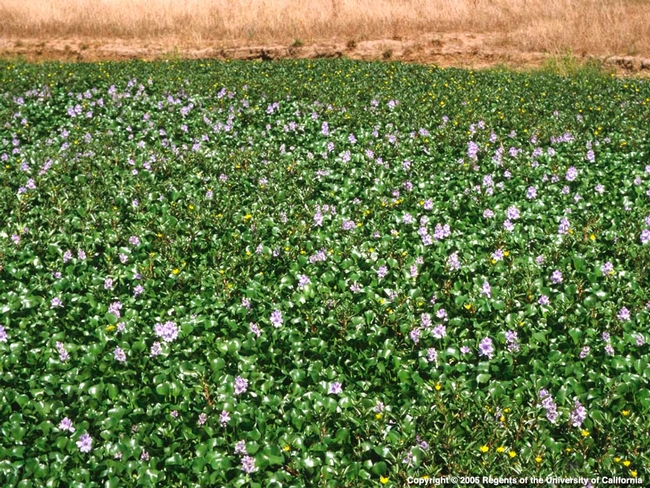People, weather and migrations move species to new locations all the time. Most newcomers (non-natives) settle in, get along with the natives and don’t interfere with human activities. In fact, some non-native species are brought in as biological controls for invasive species!
Species that become invasive can multiply fast. We may miss them when they are new and few. Some aquatic invasive plants can reproduce from a fragment and some animals can reproduce without a mate. Typically, invasive species can endure difficult environmental conditions, giving them an edge over other species.
Invasives cause problems when their populations boom. For example, waterweeds, such as Water Hyacinth, Hydrilla, Brazilian Egeria, Giant Salvinia and Spongeplant create dense mats on the surface of the water. They interfere with water flow, water delivery and navigation. The mats block sunlight, so algae in the water below cannot produce oxygen. The algae and animals in the water die and the decay process uses even more oxygen. The California State Parks’ Division of Boating and Waterways works to control waterweeds in the Sacramento-San Joaquin Delta.
Invasive species can out-compete native species for food and living space and some actually eat the natives. Quagga and Zebra Mussels, the Asian Clam and some species of Asian Carp (a catch-all term for several species of freshwater fish) out-compete other species by consuming large amounts of plankton (microscopic plants and animals). Other species of Asian Carp eat aquatic plants or small shellfish. The big, beautiful Apple Snail can decimate plants that native fish and birds need for food and shelter. Snapping Turtles, American Bullfrogs & African Clawed Frogs are voracious eaters of others and they can also out-compete for food and space. These two frogs and the Red-Eared Slider Turtle can carry disease to native animals.
Invasives that out-compete native species can cause problems up the food chain. For example, the Killer Seaweed (Caulerpa taxifolia) rapidly covers the seabed, crowding out other marine plants, because fish dislike it. Marine animals die or leave the area, because an inedible, green carpet has replaced their food. The New Zealand Mud Snail crowds out native snails, but tends to pass right through the digestive tracts of fish. The single-celled alga called Rock Snot (yuck!) or Didymo forms dense mats that smother cold-water streambeds, choking out native species that are food for trout and other fish.
Aquatic invasive species can also wreak havoc with our economic activities. The Red Swamp Crayfish and the Chinese Mitten Crab burrow in the mud, causing erosion in rice fields and levees. Quagga and Zebra Mussels and Asian Clams are probably best known for clogging water supply systems. Sharp mussel shells can cut fishing lines, anglers’ hands, and waders’ feet. Apple Snails are major pests in Asian rice fields and could pose a problem in California.
We’ll talk more in other blogs about some of these species, control programs, what you can do to alert authorities if you spot them, and how you can avoid spreading them.
This blog series is drawn from information presented in Spring 2013 workshops conducted by UC Cooperative Extension Advisors Leigh Johnson, Sabrina Drill and Darren Haver and from other reputable sources.
Attached Images:
